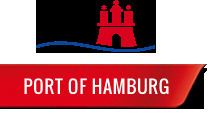Owner Hamburg Port Authority Headquarters Hamburg, Germany | Location Hamburg Type of harbor open tidal port Number of employees 10,000 | |
 | ||
Opened 7 May 1189by Frederick I Operated by Hamburg Port AuthorityHamburg Hafen und Logistik AG (HHLA) Founded 7 May 1189, Hamburg, Germany Operators Hamburg Port Authority, HHLA Similar Speicherstadt, St Pauli Piers, Elbe, Elbe Tunnel, Köhlbrand Bridge Profiles | ||
The Port of Hamburg (German mostly: Hamburger Hafen, in official usage also Hafen Hamburg) is a German sea port, located on the river Elbe in Hamburg, some 110 kilometres from the mouth of the Elbe into the North Sea.
Contents
- Map of Port of Hamburg Hamburg Germany
- The port of hamburg and journey north on the river elbe germany 14th september 2014
- History
- Access
- Cruise
- Culture
- References
Map of Port of Hamburg, Hamburg, Germany
It is Germany's largest port and is named the country's "Gateway to the World" (Tor zur Welt). In terms of TEU throughput, Port of Hamburg is the second-busiest port in Europe (after the port of Rotterdam) and 15th-largest worldwide. In 2014, 9.73 million TEUs (20-foot standard container equivalents) were handled in Hamburg.
The harbour covers an area of 73.99 km² (64.80 km² usable), of which 43.31 km² (34.12 km²) are land areas. The location is naturally advantaged by a branching Elbe, creating an ideal place for a port complex with warehousing and transshipment facilities. The extensive free port enabled toll-free storing, but this was abandoned in 2013.
The port of hamburg and journey north on the river elbe germany 14th september 2014
History
The port is almost as old as the history of Hamburg itself. Founded on 7 May 1189 by Frederick I for its strategic location, it has been Central Europe's main port for centuries and enabled Hamburg to develop early into a leading city of trade with a rich and proud bourgeoisie.
During the age of the Hanseatic League from the 13th to 16th century, Hamburg was considered second only to the port and city of Lübeck in terms of its position as a central trading node for sea-borne trade. With discovery of the Americas and the emerging transatlantic trade, Hamburg exceeded all other German ports. During the second half of the 19th century, Hamburg became Central Europe's main hub for transatlantic passenger and freight travel, and from 1871 onward it was Germany's principal port of trade. In her time the Hamburg America Line was the largest shipping company in the world. Since 1888, the HADAG runs a scheduled ferry service across various parts of the port and the Elbe. The Free Port, established on 15 October 1888, enabled traders to ship and store goods without going through customs and further enhanced Hamburg's position in sea trade with neighbouring countries. The Moldauhafen has a similar arrangement, though related to the Czech Republic exclusively.
The Speicherstadt, one of Hamburg's architectural icons today, is a large wharf area of 350,000 m² floor area on the northern shore of the river, built in the 1880s as part of the free port and to cope with the growing quantity of goods stored in the port.
Hamburg shipyards lost fleets twice after World War I and World War II, and during the partition of Germany between 1945 and 1990, the Port of Hamburg lost much of its hinterland and consequently many of its trading connections. However, since German reunification, the fall of the Iron Curtain and European enlargement, Hamburg has made substantial ground as one of Europe's prime logistics centres and as one of the world's largest and busiest sea ports.
Access
Deepening of the river Elbe for large vessels is controversial for ecological reasons. In part due to cooperation with Lower Saxony and Bremen to build a new container port (JadeWeserPort) in the deep waters of Jadebusen in Wilhelmshaven, Hamburg withdrew from this plan after a change of government in 2001.
Cruise
Hamburg is a major cruise destination and one of Europe's largest ports of call for cruise passengers traveling the Atlantic, or the Norwegian and Baltic Seas. The port is also a major location for shipbuilder and shipyards, designing, building and reconditioning yachts and cruise liners. Hamburg has three passenger terminals for cruise ships: Hamburg Cruise Center HafenCity, the Hamburg Cruise Center Altona and the Hamburg Cruise Center Steinwerder, all three capable of processing the world's largest cruise ships.
Culture
The Port of Hamburg is also one of Hamburg's largest attractions, both as a living, industrial and logistic center but also as a backdrop for modern culture and the port's history. Among these are various museum ships, musical theaters, bars, restaurants and hotels - and even a floating boat church.
The annual celebration of the harbour's birthday (Hafengeburtstag) during the first weekend of May is one of Hamburg's biggest public events. National and international visitors come to experience the festivities. Tugboats perform "ballets", old galleons and new cruise ships are open for tours, and fireworks explode at night.
Tour guides on boat tours in the harbour are called he lüchts (Low German for he is lying) after an often used call of dock workers when they overheard the stories told to tourists.
